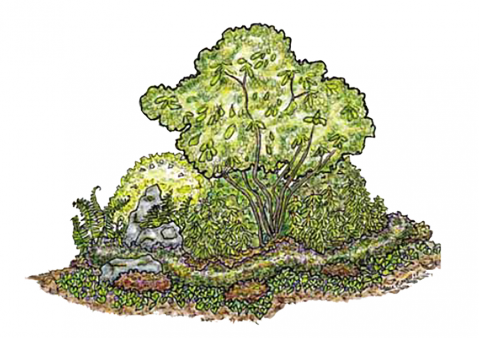Mulching - Keeping Soils Covered

Soil is a precious resource full of living organisms. It is the foundation to our gardens, landscapes and ecosystems, feeding all living organisms and building biodiversity. Nature always protects soil by almost instantly covering it with plants when it becomes bare. (Just think how quickly weeds can fill in a vegetable garden). Soil is easily degraded and lost when it is left uncovered due to drying out and/or erosion from the sun, wind, or rain. The best protection for soil is plants. Plants serve as a living mulch. Layers of plants not only cover the soil but build more soil.
In a managed garden or landscape where you may have spaces in-between plants, or the edge of a garden bed, there are a variety of other mulches that can be used. When considering mulching, use materials that not only protect and build soil, but also the best mulch to enhance the plants you want to grow. If they are herbaceous plants like non-woody annuals, vegetables or perennials, you want a leaf-type mulch. If the mulch is around woody plants and shrubs, you might aim for a woody-type mulch like wood chips. While leaf-type much can be used everywhere, you wouldn’t want to mulch a vegetable bed with wood chips.
So here are some options…
- First, if possible, use what is on your property: chopped up leaves from the fall that you run over with your lawn mower, pine needles you rake up, (contrary to popular belief, pine needles are not acidic), or compost that you have made, etcetera.
- For your shrubs and trees, see if you can get a load of woodchips from your local arborist. If they are working nearby, stop and ask if they can drop off a load (if you have the space) and give them something they might enjoy in return. Woodchips from your local arborist typically come from the branches of trees and shrubs. These branches and twigs are full of essential mineral nutrients including (N, P, K, Ca, Mg, etc.) Branches under 7 inches in diameter and less are chock full of good nutrients. You can also make your own wood chips if you have access to a woodchipper by collecting any branch and twig debris that naturally falls on your property.
- Never use too much mulch as you don’t want to encourage the roots to grow upward looking for air. Typically, three inches of mulch is good, but keep it an inch or two away from the plant stems themselves.
- Some plants like blueberries or rhododendrons grow better in acidic soil, so using peatmoss (which is acidic) works well. In contrast to that, some plants like lavender like a more alkaline “sweet soil”.
- Natural bark mulch is another option. If you want a certain color, pine, cedar and hemlock are all different shades of browns, from rust colored to almost black. Stay away from dyed mulch that could harm the healthy microorganisms in the soil.
- Stay away from manufactured mulch that does not break down (such as rubber pellets). Instead of building soil, it can harm soil life.
- If you have a big open area that needs mulch every year, perhaps add different layers of plants, including ground covers, that will serve as living mulch.
Go to https://www.mofga.org/resources/mulch/ramial-chipped-wood-more-than-wood-chips/ to learn more about ramial (smaller branch) wood chips for soil.
